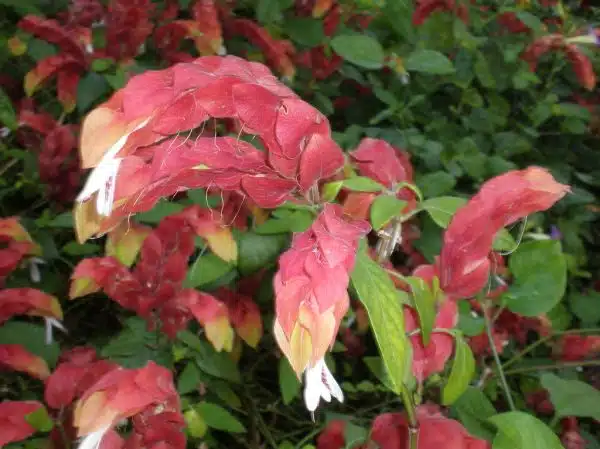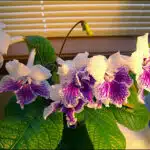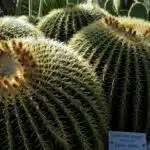Justicia brandegeana, commonly known as the shrimp plant, is a tropical perennial shrub that is native to Mexico and Central America. This unique plant is a favorite among horticulturalists and garden enthusiasts due to its distinctive appearance, with bright red or pink bracts that resemble shrimp. The Justicia brandegeana shrimp plant is an excellent addition to indoor gardens and can be grown easily with proper care.
Growing the Justicia brandegeana shrimp plant indoors requires attention to specific environmental conditions such as temperature, light, soil moisture, and nutrient levels. With the right balance of these factors, this plant can thrive in your indoor garden and bring life to your living space. In this article, we will discuss the necessary steps for successfully growing the Justicia brandegeana shrimp plant indoors and how you can enjoy its beauty all year round. Whether you are a seasoned horticulturist or a beginner looking to add some greenery to your home or office space, this article will provide you with valuable insights into nurturing this remarkable plant species.
Understanding The Justicia Brandegeana Shrimp Plant
Have you ever heard of the Justicia Brandegeana Shrimp Plant? This fascinating plant is a tropical species that originates from Mexico and other parts of Central America. It is a favorite among indoor gardeners because of its stunning appearance and relatively easy maintenance. In this article, we will explore the essential aspects of Justicia Brandegeana shrimp plant care, including tips on how to keep it healthy and thriving.
To start with, it’s important to note that the Justicia Brandegeana shrimp plant has specific care requirements to ensure its survival. These plants thrive in bright but indirect light, which means that they shouldn’t be exposed to direct sunlight for long periods. They also require adequate moisture levels, so watering should be done regularly but not excessively. Overwatering can lead to root rot and other problems.
Maintenance tips for your Justicia Brandegeana shrimp plant include pruning and fertilizing. Pruning helps maintain the shape of the plant as well as promote new growth, while fertilizing provides necessary nutrients for optimal growth. Keeping an eye out for pests such as spider mites and whiteflies is also crucial in maintaining a healthy plant. With proper care and attention, your Justicia Brandegeana shrimp plant can thrive beautifully indoors!
Moving on to selecting the right container for indoor growth…
Selecting The Right Container For Indoor Growth
Now that we have gained a comprehensive understanding of the Justicia Brandegeana Shrimp Plant, let us delve into selecting the right container for indoor growth. One crucial factor to consider is decorative containers. While it may be tempting to choose a visually appealing container, it is essential to ensure that it also serves the plant’s needs. The container must be sturdy enough to hold the soil and plant’s weight, and it should provide ample space for root growth.
Another important consideration when selecting a container is proper drainage. The roots of plants require oxygen to thrive, and if there is no outlet for excess water, they will begin to rot. Hence, choosing a container with drainage holes at the bottom or adding them yourself is a must. You can also place gravel or pebbles at the bottom of the pot before adding soil to ensure proper drainage.
In summary, selecting the right container for your Justicia Brandegeana Shrimp Plant requires more than just appearances; you need to select one that provides adequate space for root growth and has proper drainage. Decorative containers are an excellent option as long as they meet these requirements. In our next section, we’ll discuss how to choose the right soil mix for optimal growth and health of your shrimp plant.
Choosing The Right Soil Mix
Organic soil is an important factor in growing the justicia brandegeana shrimp plant indoors, as it provides the nutrients and aeration for healthy root growth and overall plant health. It is important to select a soil mix that is well-draining, as the plant will not do well in overly wet conditions. Aeration should be also taken into consideration, as this will allow the soil to receive and retain proper moisture levels. Drainage is especially important, as too much water can cause root rot and can lead to the death of the plant.
Organic Soil
As a horticulturalist, choosing the right soil mix is crucial for growing healthy plants indoors. Organic soil is an excellent option for those who want to cultivate Justicia brandegeana shrimp plants in their homes. Organic soil is made from composting natural materials like leaves, grass clippings, and food waste.
One of the benefits of using organic soil is that it contains a rich blend of nutrients that nourish the plant’s roots. Additionally, organic soil has a porous texture that allows water to penetrate through to the roots, keeping them moist and healthy. This type of soil also promotes air circulation within the pot, which helps prevent root rot.
For those with a subconscious desire to serve others, growing Justicia brandegeana shrimp plants in organic soil can be especially satisfying. Not only will you enjoy watching your plant thrive in this nutrient-rich medium, but you’ll also be contributing to a healthier environment by composting natural materials instead of throwing them away. By choosing organic soil for your indoor gardening needs, you’ll be making a positive impact on both your home and the planet.
In conclusion, using organic soil for your Justicia brandegeana shrimp plant is an excellent choice if you’re looking for a nutrient-rich and sustainable growing medium. With its porous texture and rich blend of nutrients obtained from composting natural materials like leaves and food waste, organic soil promotes healthy root growth and air circulation while preventing root rot. Moreover, growing plants in organic soil not only provides personal satisfaction but contributes to environmental sustainability as well.
Drainage
As a horticulturalist, it’s essential to consider drainage when choosing the right soil mix for your Justicia brandegeana shrimp plant. Adequate drainage is crucial to prevent waterlogging and root rot, which can be detrimental to the plant’s health. To ensure proper drainage, it’s necessary to use potting materials that allow excess water to escape freely.
When selecting potting materials for your shrimp plant, look for those that have larger particles like sand or perlite mixed with the soil. These materials create air pockets in the soil, allowing water to drain out quickly. It’s also important to use a container with drainage holes at the bottom to prevent standing water in the bottom of the pot.
Proper drainage not only prevents root rot but also affects watering frequency. A well-draining soil mix allows you to water your shrimp plant more frequently without fear of overwatering. With proper watering and good drainage, your Justicia brandegeana shrimp plant will thrive in its organic soil mix and bring beauty and joy into your home while promoting environmental sustainability through composting natural materials.
Watering And Humidity Requirements
Justicia brandegeana is a tropical plant that thrives in warm, humid environments. It’s no surprise that this plant requires moist soil to survive, but it might surprise you to learn that overwatering can be just as deadly. Overwatering can cause root rot, leading to the death of the plant. It’s important to find the right balance when watering your Justicia brandegeana, which is determined by factors including pot size, temperature and humidity, and light exposure.
To keep your Justicia brandegeana healthy and thriving, water it when the soil feels dry to the touch about an inch below the surface level. Watering frequency will depend on factors including temperature and humidity levels – during warmer months or in a more humid environment, you may need to water more frequently than in cooler or drier conditions. It’s always best to err on the side of under-watering rather than over-watering as these plants are sensitive to excess moisture. To avoid root rot and other issues associated with overwatering, ensure adequate drainage in your potting container.
In addition to proper watering frequency, controlling humidity levels can also help promote optimal growth for Justicia brandegeana. Aim for a relative humidity level between 50-60%, which can be achieved through misting or by placing a tray of water near your plant (but not directly beneath it). If you live in an area with naturally low humidity levels or are growing your plant indoors where air conditioning or heating reduces moisture in the air, consider using a humidifier to maintain adequate humidity levels for your Justicia brandegeana’s growth and health.
Maintaining proper watering frequency and controlling humidity levels are crucial components of caring for Justicia brandegeana plants indoors. In addition to these factors, lighting needs must also be considered for optimal growth.
Lighting Needs For Optimal Growth
Sunlight is an essential factor for the growth of justicia brandegeana shrimp plant indoors, as it helps with photosynthesis and provides energy for the plant to grow. Artificial lighting is a viable option to supplement the plant’s needs when sunlight is not available, but must be carefully monitored to ensure the correct spectrum of light is being supplied. Plant hormones, such as auxins, play a role in the growth of justicia brandegeana shrimp plant, as they regulate the growth of roots, stems, and leaves, and the formation of chloroplasts. Therefore, the right combination of sunlight and artificial lighting with the right plant hormones can lead to optimal growth of justicia brandegeana shrimp plant indoors.
Sunlight
Justicia Brandegeana, commonly known as the shrimp plant, is a tropical species that requires adequate sunlight to thrive indoors. When it comes to lighting needs for optimal growth, there are two options: natural and artificial light. Natural sunlight is the best option for Justicia Brandegeana because it provides the necessary spectrum of light required for photosynthesis. However, if natural sunlight is not available or insufficient, then artificial light can be used.
For those who prefer natural sunlight, it’s important to consider the location of your plant in relation to the sun’s path throughout the day. East-facing windows receive morning sun and are ideal for Justicia Brandegeana because they provide bright but indirect light. In contrast, west-facing windows receive afternoon sun which can be too intense and cause leaf burn. It’s also important to note that during winter months when daylight is shorter, supplemental lighting may be necessary.
If you choose to use artificial light for your Justicia Brandegeana, choose full-spectrum lights that mimic natural sunlight as closely as possible. LED grow lights or fluorescent lights are good options since they emit blue and red wavelengths that plants need most for growth. These lights should be placed about 12-18 inches above the plant and kept on for 12-16 hours per day.
In conclusion, whether you choose natural or artificial light for your Justicia Brandegeana shrimp plant will depend on your preference and availability of sunlight in your living space. Proper lighting is essential for optimal growth and a healthy plant overall. With proper care and attention to its lighting needs, your Justicia Brandegeana will thrive indoors year-round!
Artificial Lighting
To ensure the optimal growth of Justicia Brandegeana, it is essential to provide adequate lighting. However, natural sunlight may not always be available or sufficient for this tropical plant’s needs. In such cases, artificial lights can be used to supplement the necessary spectrum of light required for photosynthesis.
One popular option for artificial lighting is LED grow lights. These lights emit blue and red wavelengths that are crucial for plant growth and development. Additionally, they are energy-efficient and long-lasting, making them an excellent choice for indoor gardeners. When using LED lights for Justicia Brandegeana, it is recommended to place the light source about 12-18 inches above the plant and keep it on for 12-16 hours per day.
It is important to note that different plants require different light spectrums based on their unique needs. For Justicia Brandegeana, a full-spectrum LED grow light would be ideal since it mimics natural sunlight as closely as possible. By providing adequate artificial lighting along with proper care and attention, your shrimp plant will thrive indoors year-round!
Plant Hormones
As horticulturalists or plant specialists, we understand that lighting is crucial for optimal plant growth. However, lighting alone cannot guarantee a plant’s health and development. Plant hormones play an essential role in regulating various physiological processes such as growth, development, and stress response. These hormones work together with light to determine a plant’s overall performance.
Plant hormones are naturally occurring chemical messengers that regulate numerous biological functions in plants. They are produced in various parts of the plant, such as the roots, stems, leaves, flowers, and fruits. Hormone regulation influences cell division and elongation, root and shoot growth, flowering time, fruit ripening, and many other vital processes.
In terms of lighting needs for optimal growth in Justicia Brandegeana or shrimp plants specifically, hormone regulation plays a significant role. Adequate light exposure triggers the production of certain hormones responsible for photosynthesis and growth. At the same time, insufficient or inappropriate lighting can negatively impact hormone production and cause stunted growth or even death. Therefore, to ensure healthy hormone regulation in your shrimp plant indoors year-round, it is crucial to provide adequate lighting while also monitoring other factors such as temperature and humidity levels.
Temperature Considerations
Maintaining optimal temperature is crucial for the growth and development of Justicia brandegeana, also known as shrimp plant. This tropical plant thrives in warm temperatures and cannot tolerate excessively low temperatures. The optimal temperature range for this plant is between 65°F to 75°F during the day and 55°F to 65°F at night. Temperatures above or below this range can affect the plant’s growth, flowering, and overall health.
Temperature control techniques are essential to ensure that the shrimp plant is thriving indoors. One way to achieve this is by keeping the plant away from drafty areas such as vents, doors, or windows. Placing the plant in a location that receives sufficient sunlight but not direct exposure to sunlight can also help regulate temperature. In addition, using a thermometer to monitor room temperature can help identify any fluctuations that may require adjusting heating or cooling systems.
In summary, maintaining optimal temperature is crucial for growing healthy Justicia brandegeana shrimp plants indoors. Temperature control techniques such as avoiding drafty areas and monitoring room temperature can be effective ways of ensuring that your plant thrives. In the next section, we will discuss fertilization and nutrient requirements necessary for promoting healthy growth of your Justicia brandegeana shrimp plant indoors.
Fertilization And Nutrient Requirements
Fertilization and Nutrient Requirements:
Proper fertilization is crucial for the healthy growth of Justicia brandegeana shrimp plants. These plants are heavy feeders and require regular applications of organic fertilizers to maintain their health. A nutrient deficiency can result in stunted growth, yellowing leaves, and reduced flowering.
Organic fertilizers such as compost, worm castings, and fish emulsion are excellent choices for feeding Justicia brandegeana shrimp plants. These fertilizers slowly release nutrients into the soil, providing a steady supply of food for the plant. Additionally, organic fertilizers improve soil structure and promote beneficial microbial activity in the soil.
When applying fertilizer, it is important not to overdo it. Over-fertilization can lead to salt buildup in the soil, which can damage roots and cause leaf burn. To avoid this issue, follow the recommended dosage on the product label or consult with a horticulturalist for guidance. Regularly monitoring the plant’s growth and appearance is also helpful in identifying any potential nutrient deficiencies that may require additional fertilizer applications.
As mentioned earlier, nutrient deficiencies can have detrimental effects on Justicia brandegeana shrimp plant growth. Therefore, proper fertilization with organic fertilizers is essential to maintaining a healthy plant. In the subsequent section, we will discuss pruning and maintenance techniques that will further enhance your plant’s well-being.
Pruning And Maintenance
Watering justicia brandegeana shrimp plants should be done regularly and evenly to maintain an ideal moisture level. Fertilizing should also be done periodically to ensure the plant receives the necessary nutrients to promote growth. Pruning should be done with sharp scissors, and old or dead leaves should be removed. Deadheading should also be done to maintain the plant’s desired shape and encourage new growth. Repotting is necessary when the plant’s roots become cramped in its container. Trimming should be done to keep the plant’s size and shape in check.
Watering
Maintaining the proper watering frequency is crucial to the growth and health of Justicia brandegeana shrimp plants grown indoors. Overwatering or underwatering can lead to root rot, stunted growth, and ultimately death. As a horticulturalist, it is essential to check the soil moisture levels regularly and adjust watering accordingly.
The frequency of watering depends on various factors, such as the size of the pot and humidity levels in the room. Typically, Justicia brandegeana shrimp plants require watering once a week. However, it is crucial to test the soil moisture level using a moisture meter or sticking your finger into the soil. If the top inch of soil feels dry, then it’s time to water. On the other hand, if it feels moist, wait for a few more days before watering again.
It is essential to note that over-watering can be detrimental to Justicia brandegeana shrimp plants’ health since they prefer slightly dry conditions. To prevent overwatering, ensure that you use well-draining soil and avoid leaving standing water in saucers or trays beneath pots. Proper watering frequency will help maintain healthy roots and promote optimal growth for your indoor Justicia brandegeana shrimp plant.
Fertilizing
As a horticulturalist, maintaining the health and appearance of indoor plants is essential. In addition to watering, fertilizing is also crucial for the optimal growth of Justicia brandegeana shrimp plants. Fertilizers provide necessary nutrients that may not be available in the soil or may have been depleted over time.
Organic fertilizers are an excellent choice for those looking to maintain a more natural approach to plant care. They are made from naturally occurring substances and can improve soil structure and microbial activity. Organic fertilizers release nutrients slowly, ensuring that your plant receives a steady supply of nutrients over time.
On the other hand, synthetic fertilizers provide a quick nutrient boost but can be harmful if used incorrectly. These types of fertilizers contain high levels of nitrogen, phosphorus, and potassium and can cause chemical burns if not diluted properly. As such, it’s best to use synthetic fertilizers sparingly or as directed by the manufacturer. Regardless of whether you choose organic or synthetic fertilizers, it’s crucial to follow proper application guidelines to avoid harming your Justicia brandegeana shrimp plant while promoting healthy growth.
Pruning
Pruning is a crucial aspect of Justicia brandegeana shrimp plant maintenance. Pruning techniques include removing dead or damaged parts, shaping the plant, and promoting bushy growth. When pruning, it’s essential to consider timing and tools as improper pruning can harm the plant.
Deadheading is one of the most common pruning techniques used on Justicia brandegeana shrimp plants. This process involves cutting off spent flowers to encourage the production of new blooms. Shaping the plant involves trimming back any long or straggly stems to promote a fuller appearance. To control size through pruning, horticulturalists can remove up to one-third of the plant’s total growth in a single session.
Training the Justicia brandegeana shrimp plant through pruning is also possible. By selectively removing stems and branches, horticulturalists can encourage the plant to grow in a particular direction or shape. Pruning can also be used for propagation by taking stem cuttings from healthy plants and rooting them in water or soil. Lastly, pruning for aesthetics involves creating an attractive overall appearance for the plant while maintaining its health and vitality.
Propagating The Justicia Brandegeana Shrimp Plant
After pruning and maintaining your Justicia Brandegeana Shrimp Plant, the next step to ensure its growth is propagation. Propagation techniques for this plant include stem cutting or division. Stem cutting is done by taking a healthy stem with at least two leaves and placing it in moist soil until it roots. Division, on the other hand, involves separating the plant into two or more parts and replanting them individually.
Before propagating, ensure soil preparation by using a well-draining potting mix. This will prevent waterlogging and root rot that can hinder growth. The ideal pH for this plant is between 6.0 to 7.5, which can be achieved by adding lime or sulfur to adjust the soil acidity level.
By following these propagation techniques and ensuring proper soil preparation, you can successfully grow new Justicia Brandegeana Shrimp Plants from your existing ones. In the next section, we will discuss how to deal with pests and diseases that may affect the growth of your plant.
Dealing With Pests And Diseases
The justicia brandegeana shrimp plant is a popular species for indoor growth. To keep it healthy and thriving, preventative measures must be taken to reduce the chances of any pest or disease infestation. Proper sanitation and cultural practices should be followed to prevent the introduction of pests and diseases. These practices include regular cleaning of containers, proper watering and fertilization, and avoiding overcrowding of plants. In the event of an infestation, chemical or biological control methods may be employed to treat the problem. Careful consideration of the species’ needs and the pest or disease at hand is necessary when selecting a control method. Finally, prevention should be prioritized to minimize the need for any pest or disease treatments.
Pest Prevention
As a horticulturist, it is important to keep the Justicia brandegeana shrimp plant healthy and thriving. One major concern for indoor plants is pest prevention. Pests can cause significant damage to the plant and hinder its growth.
Natural pest control methods are recommended for keeping pests at bay. These methods include using insecticidal soap, neem oil, or garlic spray. Insecticidal soap works by suffocating insects, while neem oil prevents them from feeding and breeding. Garlic spray repels pests due to its strong scent. These natural remedies are safe for both the plant and humans.
In addition to natural remedies, DIY pest traps can also be used to prevent pests from spreading. Sticky traps can be made by cutting yellow index cards into strips and coating them with petroleum jelly or vegetable oil. The yellow color attracts flying insects, while the sticky surface traps them. Another trap that can be made is a beer trap for slugs and snails. Simply bury a container in the soil and fill it halfway with beer. The slugs will be attracted to the beer and fall into the container, where they will drown.
By incorporating natural pest control methods and DIY pest traps, Justicia brandegeana shrimp plants can thrive indoors without being threatened by pests. It is essential to monitor plants regularly for signs of infestation in order to take action quickly and prevent further damage from occurring.
Disease Prevention
Preventing diseases in Justicia brandegeana shrimp plants is as crucial as preventing pests. Diseases can cause severe damage to the plant and even lead to death if left untreated. As a horticulturist, it is essential to maintain the health of indoor plants by taking preventive measures against diseases.
One of the most effective ways to prevent diseases is by maintaining proper watering practices. Overwatering or underwatering can make the plant susceptible to various diseases, such as root rot and powdery mildew. Therefore, it is crucial to keep the soil evenly moist and well-drained. It is also recommended to avoid getting water on the leaves while watering since it can create a humid environment that promotes fungal growth.
Another way to prevent diseases is by keeping the plant clean and free from debris. Dead or diseased leaves, stems, and flowers should be removed regularly since they can harbor fungal spores or bacteria that can infect other parts of the plant. It is also important to sanitize pruning tools after each use with rubbing alcohol or bleach solution to prevent cross-contamination.
In conclusion, preventing disease in Justicia brandegeana shrimp plants requires diligence and attention to detail. By maintaining proper watering practices, keeping the plant clean, and removing any infected parts promptly, we can help ensure their health and longevity.
Pest/Disease Treatment
As a horticulturist, it is essential to be proactive in preventing pests and diseases that can harm plants. However, even with the best preventive measures, pests and diseases can still infect Justicia brandegeana shrimp plants. Therefore, it is crucial to have an effective pest and disease treatment plan.
One of the most effective ways to treat pests is by using natural remedies. Chemical pesticides can harm beneficial insects and pollinators, as well as the plant itself. Instead, horticulturists can use natural remedies such as neem oil or insecticidal soap to control pests like spider mites, mealybugs, and aphids. These remedies are non-toxic and safe for the environment while being effective at controlling pests.
When dealing with diseases in Justicia brandegeana shrimp plants, it is important to identify the specific disease first before treating it. Some diseases share similar symptoms but require different treatments. For example, powdery mildew can be treated with a mixture of baking soda and water or sulfur-based fungicides. In contrast, root rot requires removing infected soil and improving drainage to prevent further damage. By accurately identifying the disease present in the plant, horticulturists can apply targeted treatment solutions that are more likely to be successful in treating them effectively.
Common Growing Issues And Solutions
One common issue when growing justicia brandegeana shrimp plants indoors is the occurrence of yellow leaves. This can be caused by a variety of factors such as too much or too little water, inadequate drainage, insufficient light, or pests. To prevent yellowing leaves, it is important to ensure that the plant receives enough sunlight (ideally 4-6 hours per day), and that the soil is well-draining with proper watering techniques (allowing the top inch of soil to dry out before watering again). Additionally, regularly inspecting the plant for any signs of pests and promptly treating any infestations can also help prevent yellowing leaves.
Another potential issue that may arise when growing justicia brandegeana shrimp plants indoors is root rot. This common problem is often caused by overwatering or poorly draining soil which can lead to fungal growth and damage to the plant’s roots. To prevent root rot, it is important to use well-draining soil and avoid overwatering. It is also recommended to allow excess water to drain out of the pot after watering and not let the plant sit in standing water.
In summary, dealing with yellow leaves and preventing root rot are two common issues that may arise when growing justicia brandegeana shrimp plants indoors. By providing adequate sunlight, well-draining soil, proper watering techniques, and regular inspections for pests, these issues can be avoided. However, if these problems do occur, prompt action must be taken to ensure the health of your plant.
Displaying Your Justicia Brandegeana Shrimp Plant
Once you have successfully grown your Justicia Brandegeana shrimp plant, it’s time to think about displaying it in a way that complements its unique beauty. One popular option for showcasing this plant is by hanging it in a basket. Not only does this allow the intricate foliage to cascade down, but it also allows the plant to receive adequate sunlight from all angles.
Another display option for your Justicia Brandegeana shrimp plant is by placing it in a terrarium. This ensures that the humidity levels around the plant remain high, which is ideal for this tropical species. The enclosed environment also protects it from drafts and sudden temperature changes.
If you have multiple Justicia Brandegeana shrimp plants, consider grouping them together on a shelf or table. This creates a visually appealing display while also allowing each plant to benefit from one another’s moisture and carbon dioxide emissions. Alternatively, you can mix and match your Justicia Brandegeana shrimp plant with other indoor plants to create a lush and vibrant indoor garden space.
- Hanging baskets are an excellent method of displaying your Justicia Brandegeana shrimp plant.
- Terrariums provide ideal conditions for maintaining the proper humidity levels.
- Grouping multiple plants together can create an attractive visual display.
- Mixing and matching with other indoor plants can add variety and color to your space.
- Consider using decorative pots or containers that complement the aesthetics of your home.
Incorporating these creative display options will not only enhance the aesthetic appeal of your living space but will also improve air quality and promote relaxation. In the next section, we will delve into some additional benefits of growing the Justicia Brandegeana shrimp plant indoors.
Benefits Of Growing The Justicia Brandegeana Shrimp Plant Indoors
The Justicia Brandegeana Shrimp Plant is a stunning indoor plant that can add an exotic touch to any home. Its unique flowers resemble tiny pink shrimp, and it’s easy to see why this plant has become such a popular choice for indoor gardeners. The benefits of growing the Justicia Brandegeana Shrimp Plant indoors are numerous, from its beautiful appearance to its air-purifying qualities.
One of the main benefits of growing the Justicia Brandegeana Shrimp Plant indoors is its ability to purify the air. This plant is known for removing harmful toxins from the air in your home, making it an excellent choice for those who suffer from allergies or respiratory problems. Additionally, caring for this plant is relatively easy, making it an ideal option for those who are new to gardening.
When it comes to caring for your Justicia Brandegeana Shrimp Plant, there are a few things to keep in mind. First and foremost, this plant requires bright but indirect sunlight, so be sure to place it in a well-lit area of your home. Additionally, make sure that you water it regularly and keep the soil moist but not overly wet. With proper care, your shrimp plant will thrive and continue to provide you with beautiful blooms year after year.
| Benefits | Care tips |
|---|---|
| Air-purifying qualities | Bright but indirect sunlight |
| Unique and exotic appearance | Regular watering |
| Relatively easy to care for | Moist but not overly wet soil |
As you can see from the above table, there are several benefits of growing the Justicia Brandegeana Shrimp Plant indoors. Not only does this plant have air-purifying qualities that can improve the overall quality of your home’s air, but it also provides a unique and exotic touch to your decor. By following some simple care tips such as providing bright but indirect sunlight and regular watering, you can enjoy the beauty of this plant for years to come. In the next section, we will answer some frequently asked questions about indoor shrimp plant care to help ensure that your plant thrives.
Frequently Asked Questions About Indoor Shrimp Plant Care
Common problems that may arise when growing the Justicia brandegeana shrimp plant indoors include issues with watering, lighting, and pests. Overwatering can lead to root rot, while underwatering can cause the leaves to wilt and drop. It is important to strike a balance between keeping the soil moist but not waterlogged. The shrimp plant requires bright, indirect light and may struggle in low-light conditions. Mealybugs and spider mites are common pests that may infest the plant. Keep an eye out for any signs of these pests and address them promptly with appropriate measures.
Troubleshooting tips for these common problems involve adjusting watering habits or providing additional light sources for the plant. If you suspect a pest infestation, isolate the affected plant and treat it with insecticidal soap or neem oil. In general, it is best to avoid over-fertilizing the shrimp plant as this may lead to excessive foliage growth at the expense of flower production.
Best practices for indoor shrimp plant care include ensuring proper drainage in your potting mix, maintaining consistent humidity levels, and fertilizing sparingly with a balanced fertilizer during the growing season. Expert advice recommends repotting every 2-3 years as necessary to refresh the soil nutrients and prevent overcrowding of roots.
Transition: With these tips in mind, you can successfully grow your Justicia brandegeana shrimp plant indoors. However, there are additional factors to consider when cultivating an indoor garden that will be discussed in our next section on conclusion: growing your indoor garden with Justicia brandegeana.
Conclusion: Growing Your Indoor Garden With Justicia Brandegeana
Justicia Brandegeana, commonly known as the shrimp plant, is a unique and versatile addition to any indoor garden. With its vibrant colors and distinctive shape, it adds a touch of tropical flair to any space. When growing Justicia Brandegeana indoors, it is important to consider several factors such as lighting requirements, soil testing, and watering needs.
To ensure healthy growth, provide your shrimp plant with bright but indirect sunlight. Too much direct sunlight can scorch the leaves, while too little light can cause stunted growth. Additionally, regularly test the soil to ensure proper pH levels and nutrient balance. Shrimp plants prefer slightly acidic soil with good drainage. Overwatering can lead to root rot, so be sure to allow the top inch of soil to dry out before watering again.
Incorporating Justicia Brandegeana into your indoor decor is easy and fun! Its unique shape makes it an ideal centerpiece or accent piece in any room. Try pairing it with other tropical plants for a cohesive look or use it as a statement piece on its own. With proper care and attention, your shrimp plant will thrive in your indoor garden for years to come.
Conclusion
The Justicia Brandegeana Shrimp Plant is a unique and attractive houseplant that can thrive indoors with the right care. As a plant specialist, it is important to understand the specific requirements for growing this plant successfully indoors.
Selecting the appropriate container, soil mix, and providing proper watering and humidity are essential for healthy growth. Additionally, ensuring sufficient lighting is crucial to encourage blooming.
Growing the Justicia Brandegeana Shrimp Plant indoors not only adds beauty to your indoor garden but also offers numerous benefits such as air purification and stress reduction. With proper care, this plant can bring joy and tranquility to any living space.
In conclusion, have you considered adding the Justicia Brandegeana Shrimp Plant to your indoor garden collection? As a horticulturalist, I recommend it for its unique appearance and low maintenance characteristics. By following the guidelines provided in this article, you can create an ideal environment for optimal growth of this beautiful plant. So why not give it a try? You may be pleasantly surprised by the results!
Image Credits
- “Shrimp plant flowers (Justicia brandegeana)” by Joel Abroad (featured)





























